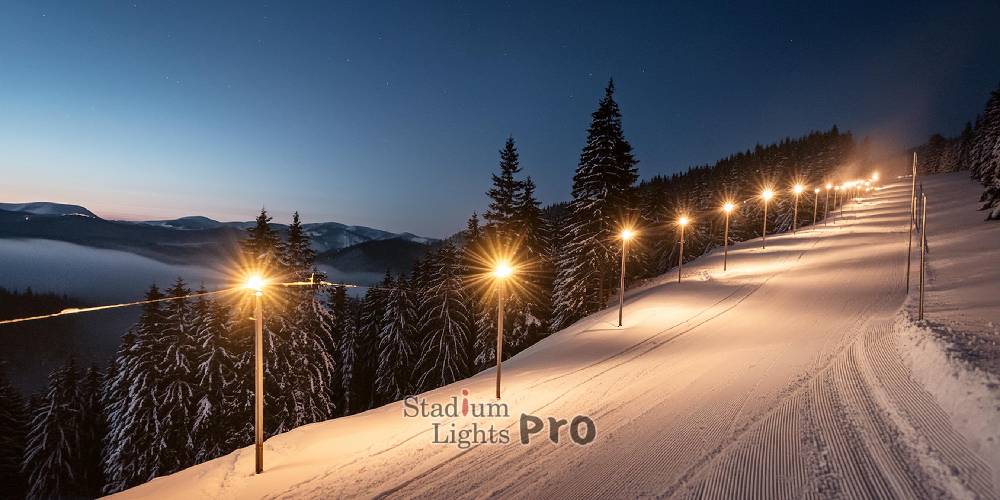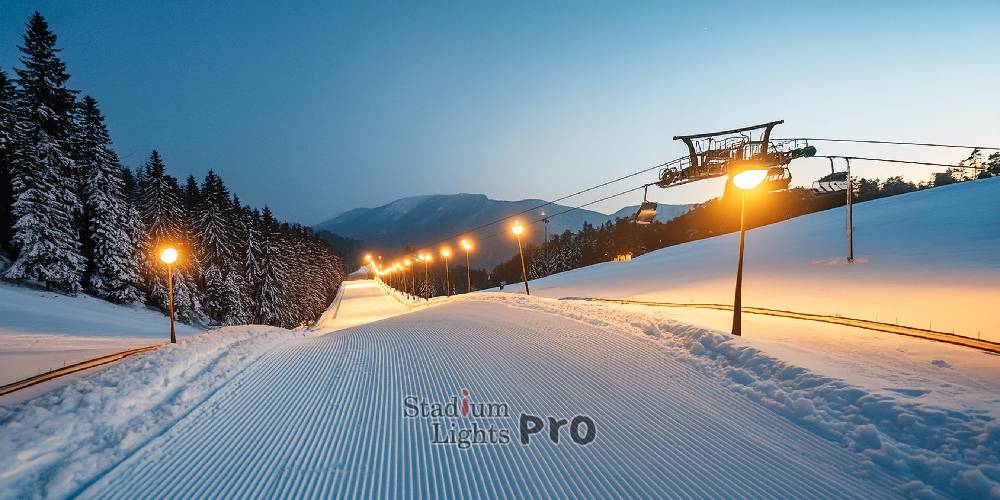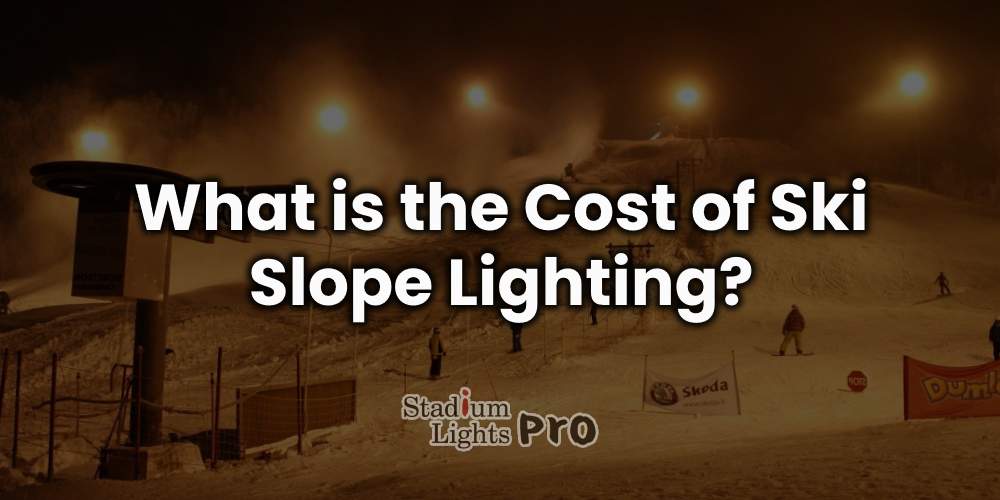Ski slope lighting systems consist of strategically placed fixtures that illuminate the slopes, providing skiers and snowboarders with visibility in low-light conditions. Beyond simply extending the hours of operation, ski slope lighting significantly contributes to the overall experience of winter sports enthusiasts, allowing them to enjoy the slopes well into the evening.
The importance of ski slope lighting cannot be overstated, particularly in regions with shorter daylight hours during the winter season. By illuminating the slopes after sunset, resorts can cater to visitors who may have limited time during the day or who prefer to ski under the enchanting glow of twilight. This extended access not only enhances the overall guest experience but also maximizes revenue opportunities for resorts by accommodating a broader range of schedules and preferences.
Moreover, ski slope lighting plays a pivotal role in ensuring the safety of skiers and snowboarders navigating the slopes after dark. Properly illuminated runs offer improved visibility, allowing individuals to better discern changes in terrain, obstacles, and other skiers. This heightened visibility reduces the risk of accidents and injuries, creating a safer environment for guests to enjoy their winter sports activities.
In essence, ski slope lighting serves as a cornerstone for both safety and enjoyment in the world of winter sports, enabling resorts to provide unparalleled experiences for guests while extending their operational hours to capitalize on the magic of the mountains, day or night.
Table of Contents
ToggleFactors influencing the cost of ski slope lighting

Size and complexity of the slope
The size and complexity of a ski slope are primary determinants of the cost of implementing lighting systems. Larger slopes with more extensive terrain coverage require a greater number of lighting fixtures and infrastructure, driving up initial installation costs. Additionally, slopes with varying degrees of difficulty or challenging terrain may necessitate specialized lighting solutions to ensure consistent illumination and safety throughout the entire area. As the size and complexity of the slope increase, so too does the complexity of the lighting design and installation process, contributing to higher overall costs.
Type and quality of lighting fixtures
The type and quality of lighting fixtures selected for a ski slope directly impact both the upfront installation costs and long-term operational expenses. High-quality, durable fixtures designed specifically for outdoor use and capable of withstanding harsh weather conditions typically command a higher initial investment but offer greater reliability and longevity, ultimately reducing maintenance and replacement costs over time. Additionally, factors such as brightness, color temperature, and beam spread influence the effectiveness of the lighting system in providing adequate visibility and safety for skiers and snowboarders, further affecting the overall cost of the lighting project.
Installation requirements and terrain challenges
Installing lighting on ski slopes presents unique challenges due to the rugged terrain and environmental conditions inherent to mountainous regions. Terrain features such as steep slopes, rocky terrain, and dense vegetation can complicate the installation process and may require specialized equipment and techniques, adding to labor costs and overall project expenses. Moreover, factors such as accessibility, elevation, and proximity to power sources influence the logistics of installing lighting infrastructure, further impacting the cost and complexity of the project.
Energy efficiency considerations
Energy efficiency is a critical consideration in ski slope lighting projects, as the operational costs associated with powering the lighting fixtures can be substantial over time. Choosing energy-efficient lighting technologies, such as LED fixtures, can significantly reduce electricity consumption and long-term operating expenses while minimizing environmental impact. While energy-efficient lighting solutions may entail higher upfront costs, the potential for cost savings through reduced energy consumption and lower utility bills makes them a financially prudent investment for ski resorts seeking to minimize operating expenses and maximize sustainability efforts.
Maintenance and operational costs
In addition to upfront installation costs, ski slope lighting projects entail ongoing maintenance and operational expenses that must be factored into the overall cost analysis. Regular maintenance activities, such as cleaning, bulb replacement, and system inspections, are necessary to ensure optimal performance and longevity of the lighting system. Furthermore, operational costs associated with electricity consumption, personnel, and administrative overhead contribute to the total cost of operating the lighting system throughout its lifecycle. Implementing proactive maintenance strategies and leveraging energy-efficient technologies can help mitigate these ongoing costs and ensure the continued effectiveness and reliability of the lighting system.
Breakdown of costs
| Cost Component | Estimated Cost Range (USD) | Details |
|---|---|---|
| Initial Installation Costs | ||
| – Lighting Fixtures | $50,000 – $200,000 | Cost of purchasing and installing lighting fixtures, including floodlights, spotlights, and other fixtures required for proper illumination. |
| – Cabling and Infrastructure | $20,000 – $100,000 | Cost of materials (cables, conduits, junction boxes) and labor for installing electrical infrastructure to power and control the lighting system. |
| – Labor Costs | $30,000 – $100,000 | Cost of skilled technicians, electricians, and construction workers involved in planning, design, and installation of lighting infrastructure. |
| Ongoing Operational Costs | ||
| – Electricity Expenses (per month) | $5,000 – $20,000 | Monthly cost of electricity to power the lighting system, influenced by number and wattage of fixtures, energy efficiency, and local electricity rates. |
| – Maintenance and Repair Costs (per year) | $10,000 – $50,000 | Annual expenses for routine maintenance, bulb replacements, repairs, and inspections to ensure functionality and safety of lighting system. |
| – Personnel Costs (per year) | $20,000 – $80,000 | Annual wages for staff overseeing and managing lighting system, including maintenance technicians, electricians, and administrative personnel. |
| Long-term Considerations | ||
| – Upgrades and Replacements | Variable | Variable costs for upgrading or replacing fixtures, infrastructure, or control systems to maintain performance and meet safety and regulatory standards. |
| – Environmental Impact and Sustainability Efforts | Variable | Variable expenses for sustainability initiatives, such as energy-efficient upgrades, habitat restoration, and environmental monitoring, to minimize ecological footprint. |
Initial installation costs
Lighting fixtures
One of the primary cost factors in ski slope lighting projects is the selection and procurement of lighting fixtures. The cost of lighting fixtures varies depending on factors such as type, quality, brightness, and features. High-quality fixtures designed for outdoor use and capable of withstanding harsh weather conditions typically command a higher price but offer greater durability and longevity, reducing the need for frequent replacements and maintenance. Additionally, specialized fixtures designed for specific lighting requirements, such as floodlights for wide-area illumination or spotlights for focused lighting on obstacles or features, may incur higher costs but are essential for achieving optimal visibility and safety on the slopes.
Cabling and infrastructure
The installation of cabling and infrastructure to support the lighting system is another significant component of initial installation costs. This includes the purchase of cables, conduits, junction boxes, and other electrical components necessary for distributing power to the lighting fixtures throughout the ski slope. The cost of cabling and infrastructure is influenced by factors such as the size and layout of the slope, the distance between lighting fixtures, and the complexity of the electrical distribution network. Additionally, considerations such as terrain challenges, elevation changes, and environmental conditions may require specialized equipment and techniques, adding to the overall cost of infrastructure installation.
Labor costs
Labor costs associated with the installation of ski slope lighting include wages for skilled technicians, electricians, and construction workers involved in the planning, design, and implementation of the lighting system. The complexity of the installation process, as well as factors such as terrain challenges, accessibility, and weather conditions, can impact labor costs significantly. Additionally, specialized knowledge and expertise may be required for tasks such as trenching, cable laying, fixture mounting, and electrical connections, contributing to higher labor expenses. Proper planning and coordination are essential to optimize labor efficiency and minimize installation time, thereby reducing overall labor costs associated with the project.
Ongoing operational costs
Electricity expenses
Electricity expenses represent a significant portion of the ongoing operational costs associated with ski slope lighting. The amount of electricity consumed by the lighting system depends on factors such as the number and wattage of lighting fixtures, the duration and frequency of operation, and the efficiency of the lighting technology employed. Energy-efficient lighting technologies, such as LED fixtures, can help reduce electricity consumption and minimize operational expenses over time. Implementing strategies to optimize energy use, such as dimming or scheduling lighting based on occupancy patterns or time of day, can further mitigate electricity expenses and improve cost-effectiveness.
Maintenance and repair costs
Regular maintenance and repair activities are essential to ensure the continued performance and reliability of ski slope lighting systems. Maintenance tasks may include cleaning fixtures to remove dirt and debris, inspecting cables and connections for signs of wear or damage, and replacing bulbs or components that have reached the end of their lifespan. Additionally, proactive maintenance practices, such as routine inspections and preventive repairs, can help identify and address potential issues before they escalate into costly repairs or system failures. Budgeting for ongoing maintenance and repair costs is critical to ensure the long-term sustainability and effectiveness of the lighting infrastructure.
Personnel costs
Personnel costs associated with ski slope lighting operations encompass wages for staff responsible for overseeing and managing the lighting system, including maintenance technicians, electricians, and administrative personnel. Personnel may be tasked with various responsibilities, such as scheduling maintenance activities, monitoring system performance, responding to repair requests, and coordinating with external contractors or vendors as needed. The number and skill level of personnel required depend on factors such as the size and complexity of the lighting system, the frequency of maintenance activities, and the level of automation or remote monitoring capabilities. Efficient staffing practices and training programs can help optimize personnel costs while ensuring the effective operation and maintenance of ski slope lighting systems.
Long-term considerations

Upgrades and replacements
Over time, advances in lighting technology and changes in regulatory requirements may necessitate upgrades or replacements to existing ski slope lighting systems. Upgrades may involve retrofitting fixtures with more energy-efficient bulbs or components, installing smart lighting controls for improved efficiency and flexibility, or expanding the lighting infrastructure to cover additional terrain or enhance visibility in specific areas. Similarly, as lighting fixtures reach the end of their lifespan or become obsolete, they may need to be replaced with newer, more technologically advanced models to ensure optimal performance and safety. Budgeting for regular upgrades and replacements is essential to mitigate the risk of system obsolescence and maintain the long-term viability of ski slope lighting infrastructure.
Environmental impact and sustainability efforts
In recent years, there has been a growing emphasis on environmental sustainability and minimizing the ecological footprint of ski resorts and recreational facilities. Ski slope lighting systems can have a significant environmental impact due to electricity consumption, light pollution, and habitat disruption. To mitigate these effects, ski resorts are increasingly implementing sustainability initiatives and adopting environmentally friendly practices in their lighting operations. This may include investing in energy-efficient lighting technologies, such as LED fixtures, to reduce electricity consumption and carbon emissions, as well as implementing lighting control strategies to minimize light spillage and glare. Additionally, resorts may engage in habitat restoration efforts, such as replanting vegetation or creating wildlife corridors, to mitigate the ecological impact of lighting infrastructure on local ecosystems. By prioritizing environmental stewardship and sustainability in ski slope lighting projects, resorts can minimize their environmental footprint while preserving the natural beauty and ecological integrity of mountain environments for future generations.
Case studies/examples
Comparison of costs for different ski resorts or slopes
Comparing the costs of ski slope lighting across different resorts or slopes provides valuable insights into the factors influencing overall expenses and the range of investment required for implementing lighting infrastructure. For example, a comparative analysis may reveal that larger resorts with extensive terrain coverage and complex lighting requirements incur higher installation and operational costs compared to smaller, more modestly sized slopes. Additionally, geographic factors such as elevation, climate, and terrain challenges can significantly impact the cost of installing and maintaining lighting systems. By examining case studies from various ski resorts or slopes, stakeholders can gain a better understanding of cost benchmarks and best practices for optimizing the financial efficiency and effectiveness of ski slope lighting projects.
Success stories highlighting cost-effective lighting solutions
Success stories highlighting cost-effective lighting solutions demonstrate innovative approaches and strategies for achieving optimal visibility, safety, and energy efficiency on ski slopes while minimizing operational expenses and environmental impact. For instance, a ski resort may implement a comprehensive lighting retrofit project, replacing outdated fixtures with energy-efficient LED technology and installing smart lighting controls to optimize energy use and reduce electricity expenses. By leveraging advanced lighting technologies and control systems, the resort can achieve significant cost savings while enhancing the overall guest experience and sustainability credentials. Similarly, case studies showcasing collaborative partnerships between ski resorts, technology vendors, and energy providers can illustrate how innovative financing models, such as performance-based contracts or energy savings agreements, can facilitate the implementation of cost-effective lighting solutions with minimal upfront investment. By sharing success stories and lessons learned from real-world projects, stakeholders can glean valuable insights and inspiration for planning and executing their own ski slope lighting initiatives.
Conclusion
The cost of ski slope lighting is influenced by various factors, including the size and complexity of the slope, the type and quality of lighting fixtures, installation requirements and terrain challenges, energy efficiency considerations, and ongoing maintenance and operational costs. These factors interact to determine the overall investment required for implementing and maintaining lighting infrastructure on ski slopes.
While cost considerations are important in ski slope lighting projects, it is essential to prioritize safety and operational needs to ensure the wellbeing of skiers and snowboarders and the overall success of the resort. Ski slope lighting plays a crucial role in enhancing visibility and safety on the slopes, allowing guests to enjoy their winter sports activities with confidence and peace of mind. By balancing cost considerations with safety and operational requirements, ski resorts can optimize their investments in lighting infrastructure to maximize the value and benefits for guests and stakeholders alike.

